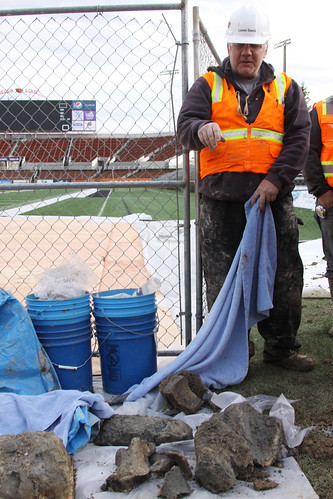
Femur bone. Source: Loren Davis
CORVALLIS, Ore. –(ENEWSPF)–January 28, 2016. On Saturdays in the fall, cleats pound the turf at Reser Stadium at Oregon State University. But new evidence dug up during an expansion of the Valley Football Center has revealed that some much larger creatures once roamed this location more than 10,000 years ago.
Construction crews digging in the north end zone in Reser Stadium on Monday uncovered a large femur bone, likely from a mammoth. Further discovery revealed more bones from several extinct mammals.
“There are quite a few bones, and dozens of pieces,” said Loren Davis, an associate professor of anthropology at OSU who was called to the site after the initial discovery was made. “Some of the bones are not in very good shape, but some are actually quite well preserved.”
There don’t appear to be any signs of human bones or artifacts at the site, Davis said. Further testing will be needed to determine the bones’ exact age.
The discovery of the ancient mammal bones is not unusual in the Willamette Valley, Davis said. The bones, including mammoth, bison and some kind of camel or horse, were discovered in a 10-foot deep plot in an area that could once have been a bog or marsh, Davis said.
“Animals who were sick would often go to a body of water and die there, so it’s not unusual to find a group of bones like this,” Davis said. “We had all of these types of animals in the Willamette Valley back then.”
Crews are digging up a portion of the north end zone as part of the Valley Football Center expansion and renovation project. Work began after the fall football season ended and is slated for completion by the start of the 2016 home season.

A worker digging in the area made the initial discovery of the large femur bone and immediately stopped work in the area, said Tim Sissel, senior project manager for Hunt/Fortis, a joint venture, the general contractor on the project.
Company officials notified OSU officials, who brought in Davis and other experts to examine the bones and the site. Crews have moved to other areas of the construction project while Davis and others take a closer look at the find. The delay has been minimal so far, Sissel said.
The animals do not appear to have been killed, Davis said, and there is no other evidence of humans at the site. Since the find does not appear to involve humans or human artifacts, the bones are not considered part of an archaeological site, Davis said. Nonetheless, we can learn a great deal about what the ancient environment of the Willamette Valley was like from this discovery, he said.
The find does not appear to involve humans or human artifacts and there are no special rules or regulations in Oregon governing the preservation or protection of paleontology finds, Davis said.
In the short term, Davis plans to soak the discovered bones in water to prevent further deterioration, and hopes to send some out for carbon dating to determine more about their age. He and his students will also continue excavating a large pile of dirt pulled from the site, where more bones are believed to be buried.
“It’ll be a great learning experience for them, to learn how to identify extinct animal bones,” Davis said. “It’s really an amazing find.”
About Oregon State University: OSU is one of only two U.S. universities designated a land-, sea-, space- and sun-grant institution. OSU is also Oregon’s only university to hold both the Carnegie Foundation’s top designation for research institutions and its prestigious Community Engagement classification. Its more than 26,000 students come from all 50 states and more than 90 nations. OSU programs touch every county within Oregon, and its faculty teach and conduct research on issues of national and global importance.
Source: http://www.oregonstate.edu








